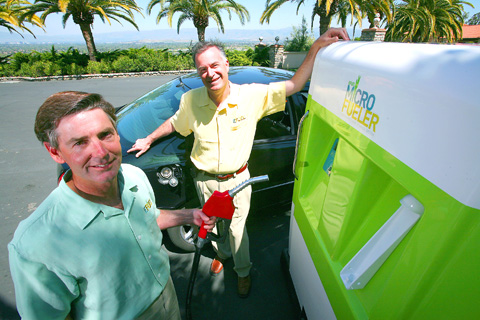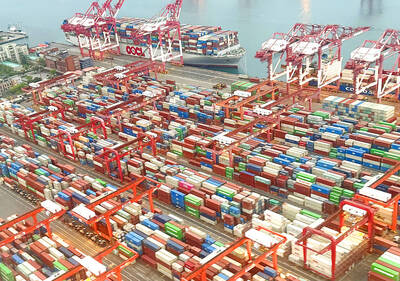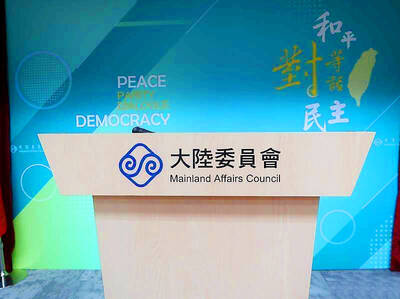What if you could make fuel for your car in your backyard for less than you pay at the pump? Would you?
The first question has driven Floyd Butterfield for more than two decades. Butterfield, 52, is something of a legend for people who make their own ethanol. In 1982, he won a California Department of Food and Agriculture contest for best design of an ethanol still, albeit one that he could not market profitably at the time.
Now he thinks that he can, thanks to his partnership with the Silicon Valley entrepreneur Thomas Quinn. The two have started the E-Fuel Corp, which will soon announce its home ethanol system, the E-Fuel 100 MicroFueler. It will be about as large as a stackable washer-dryer, sell for US$9,995 and ship before year-end.

PHOTO: NY TIMES NEWS SERVICE
The net cost to consumers could drop by half after government incentives for alternate fuels, such as tax credits, are applied.
The MicroFueler will use sugar as its main fuel source, or feedstock, along with a specially packaged time-release yeast the company has developed. Depending on the cost of sugar, plus water and electricity, the company says it could cost as little as a US$1 a gallon (US$0.26 per liter) to make ethanol. In fact, Quinn sometimes collects leftover alcohol from bars and restaurants in Los Gatos, California, where he lives, and turns it into ethanol; the only cost is for the electricity used in processing.
In general, he says, burning a gallon of ethanol made by his system will produce one-eighth the carbon of the same amount of gasoline.
“It’s going to cause havoc in the market and cause great financial stress in the oil industry,” Quinn boasts.
He may well turn out to be right. But brewing ethanol in the backyard isn’t as easy as barbecuing hamburgers. Distilling large quantities of ethanol has typically required a lot of equipment, says Daniel Kammen, director of the Renewable and Appropriate Energy Laboratory at the University of California, Berkeley. In addition, he says that quality control and efficiency of home brew usually pale compared with those of commercial refineries.
Quinn, 53, has been involved with successful innovations before. For instance, he patented the motion sensor technology used in Nintendo’s wildly popular Wii gaming system.
More to the point, he was the product marketing manager for Alan Shugart’s pioneering hard disk drive when the personal computer was shifting from a hobbyists’ niche to a major industry.
“I remember people laughing at us and saying what a stupid idea it was to do that disk drive,” Quinn says.
Butterfield thinks that the MicroFueler is as much a game changer as the personal computer. He says that working with Quinn’s microelectronics experts — E-Fuel now employs 15 people — has led to breakthroughs that have cut the energy requirements of making ethanol in half. One such advance is a membrane distiller, which, Quinn says, uses extremely fine filters to separate water from alcohol at lower heat and in fewer steps than in conventional ethanol refining. Using sugar as a feedstock means that there is virtually no smell and its water byproduct will be drinkable.
E-Fuel has bold plans: It intends to operate internationally from the start, with production of the MicroFueler in China and the UK as well as the US. And Butterfield is already at work on a version for commercial use, as well as systems that will use feedstocks other than sugar.
Ethanol has long had home brewers and permits are available through the Alcohol and Tobacco Tax and Trade Bureau. You must be a property owner and agree to make your ethanol outdoors.
But there are plenty of reasons to question whether personal fueling systems will become the fuel industry’s version of the personal computer.
For starters, sugar-based ethanol doesn’t look much cheaper than gas. Raw sugar sells in the US for about US$0.20 a pound (0.45kg) and it takes 10 pounds to 14 pounds of sugar to make a gallon (3.79 liters) of ethanol, says Michael Salassi, a professor in the department of agricultural economics at Louisiana State University. But Quinn says that as of January, under the North American Free Trade Agreement, he can buy inedible sugar from various markets for as little as US$0.025 a pound, which puts the math in his favor. While this type of sugar has not been sold to consumers, E-Fuel says it is developing a distribution network for it.
In addition, it’s illegal in the US to operate a car on 100 percent ethanol, with exceptions for off-road vehicles like Indy cars and farm equipment.
Quinn has a federal permit to make his own fuel and believes that if MicroFuelers start popping up like swimming pools, regulators will adapt by certifying pure ethanol for cars.
Despite all the hurdles, Quinn and Butterfield may be on to something. There are plenty of consumers who want to reduce their carbon footprint and are willing to make an upfront investment to do it — consider the success of the Prius.

MORE VISITORS: The Tourism Administration said that it is seeing positive prospects in its efforts to expand the tourism market in North America and Europe Taiwan has been ranked as the cheapest place in the world to travel to this year, based on a list recommended by NerdWallet. The San Francisco-based personal finance company said that Taiwan topped the list of 16 nations it chose for budget travelers because US tourists do not need visas and travelers can easily have a good meal for less than US$10. A bus ride in Taipei costs just under US$0.50, while subway rides start at US$0.60, the firm said, adding that public transportation in Taiwan is easy to navigate. The firm also called Taiwan a “food lover’s paradise,” citing inexpensive breakfast stalls

TRADE: A mandatory declaration of origin for manufactured goods bound for the US is to take effect on May 7 to block China from exploiting Taiwan’s trade channels All products manufactured in Taiwan and exported to the US must include a signed declaration of origin starting on May 7, the Bureau of Foreign Trade announced yesterday. US President Donald Trump on April 2 imposed a 32 percent tariff on imports from Taiwan, but one week later announced a 90-day pause on its implementation. However, a universal 10 percent tariff was immediately applied to most imports from around the world. On April 12, the Trump administration further exempted computers, smartphones and semiconductors from the new tariffs. In response, President William Lai’s (賴清德) administration has introduced a series of countermeasures to support affected

CROSS-STRAIT: The vast majority of Taiwanese support maintaining the ‘status quo,’ while concern is rising about Beijing’s influence operations More than eight out of 10 Taiwanese reject Beijing’s “one country, two systems” framework for cross-strait relations, according to a survey released by the Mainland Affairs Council (MAC) on Thursday. The MAC’s latest quarterly survey found that 84.4 percent of respondents opposed Beijing’s “one country, two systems” formula for handling cross-strait relations — a figure consistent with past polling. Over the past three years, opposition to the framework has remained high, ranging from a low of 83.6 percent in April 2023 to a peak of 89.6 percent in April last year. In the most recent poll, 82.5 percent also rejected China’s

PLUGGING HOLES: The amendments would bring the legislation in line with systems found in other countries such as Japan and the US, Legislator Chen Kuan-ting said Democratic Progressive Party (DPP) Legislator Chen Kuan-ting (陳冠廷) has proposed amending national security legislation amid a spate of espionage cases. Potential gaps in security vetting procedures for personnel with access to sensitive information prompted him to propose the amendments, which would introduce changes to Article 14 of the Classified National Security Information Protection Act (國家機密保護法), Chen said yesterday. The proposal, which aims to enhance interagency vetting procedures and reduce the risk of classified information leaks, would establish a comprehensive security clearance system in Taiwan, he said. The amendment would require character and loyalty checks for civil servants and intelligence personnel prior to